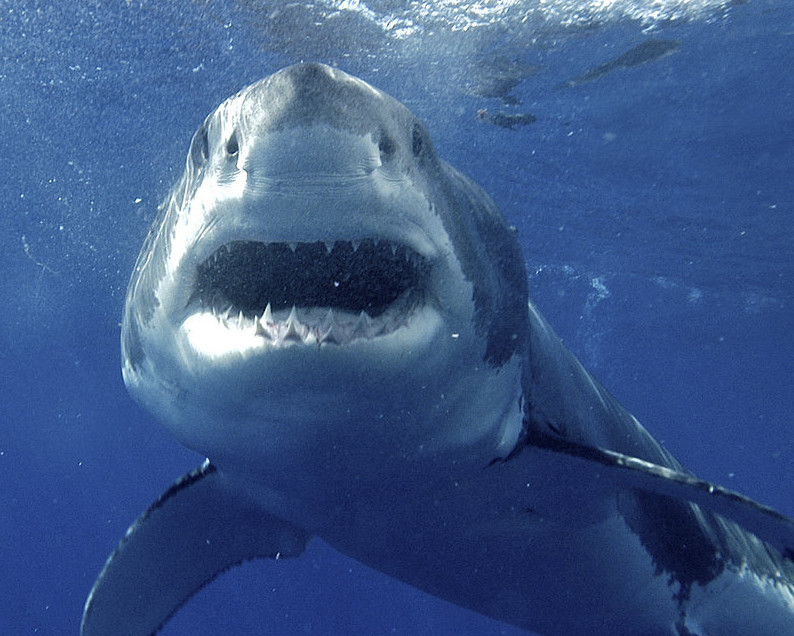The great white shark can rocket through water at 35 mph, kill its prey with frightening speed and efficiency — and awaken in humans the stuff of nightmares.
“The shark is from under the water (and) it represents the unconscious … a domain we’re afraid to explore, symbolically speaking,” says Rick Bouchard, a clinical social worker in Portland and a Jungian analyst in training.
That fear was triggered recently by reports that a great white shark stalked a kayaker off a beach in Orleans, Mass., on Cape Cod, and that another attacked a person in the waters off Santa Cruz, Calif. That shark attacked — or at least nipped — a kayak without harming the paddler. Still more reports lay blame on great whites for the slaughter of seals off Truro, Mass., also on the Cape, and alleged sightings have occurred several times in recent years in other towns along the peninsula.
Problem is, after the tide of public hysteria ebbs, it turns out the sharks in question often are not great whites and likely pose no threat.
Shark attacks “are very uncommon,” according to Aimee Hayden-Rodriques, aquarium manager and state science educator at the Main State Aquarium in West Boothbay Harbor.
Of the more than 375 species of sharks found in the oceans, roughly 30 — less than 10 percent — have been reported to attack humans.
Fifty-three shark attacks were reported in the United States in 2000, and only one was fatal. In 2011, there were 29 attacks and no fatalities reported, according to the International Shark Attack File at the Florida Museum of Natural History.
In the widely publicized event on Cape Cod, the shark trailing a kayaker, some shark experts believe, was a generally harmless basking shark — still the second-largest fish in the world, often measuring 25 feet long at maturity, but not aggressive toward humans.
The basking shark, which is found in temperate waters around the world, including the Gulf of Maine, is mostly disinterested in human beings, marine biologists say. It feeds on plankton, the tiny organisms that are the foundation of the ocean food chain.
With great whites, what we don’t know is scarier than what we discover through study and experience, Hayden-Rodriques said.
“People panic,” she said. “It’s crazy.”
To Mae Taylor, a marine biologist and adjunct professor in biology at Salem State University in Salem, Mass., “It’s fear of the unknown.”
In reality, Taylor said, sharks are the most important fish in the ocean because they cull the weak and sick fish and marine mammals that require less energy to hunt and kill.
Although the great white can be found in the Gulf of Maine, the chance that a person will see one — let alone get up close and personal — is small.
Usually, great white sharks stay farther offshore, in waters 750 to 1,000 feet deep. Frequently, they roam over huge territories, traveling thousands of miles every year.
No one knows for sure what causes the shark — the great white tends to be solitary — to come close to shore or near beaches where people congregate.
One theory is that it may be pursuing seals, a delicacy for great whites, or following schools of fish on which it customarily feeds — pollock, for example.
Sometimes the only way a shark can sense the difference between a human and its customary prey is by biting — a sign Hayden-Rodriques takes as an explanation for why, worldwide, most people attacked by sharks survive. “Our blood tastes different than fish blood,” she said, and presumably isn’t part of their preferred diet.
The element of surprise doesn’t make the confrontation easier, or safer. Since large sharks are seldom seen along beaches, the rare instance provokes a lot of fear and reawakens outdated, misinformed ideas about them.
Then, too, there’s the “Jaws” effect.
“Jaws,” the 1974 novel by Peter Benchley and the movie version a year later, recounts the story of a great white shark that preys on a small resort town and the voyage of three men who hunt it down.
” ‘Jaws’ did terrible things to sharks,” Hayden-Rodriques said. Both a literary and cinematic hit at the time, the images of that great white imprinted a whole generation — and their children — with terror about a creature that rarely attacks people.
“But being cautious of things bigger than us that we don’t understand, in an environment we don’t understand,” makes good sense, she said. Most campers, for example, know what animals could pose a threat to them, and they plan accordingly, even identifying a possible escape route from predators.
But the sea is not the human world.
“Humans,” said Hayden-Rodriques, “kill millions of sharks a year.”
Staff Writer North Cairn can be contacted at 791-6325 or at: ncairn@pressherald.com
Send questions/comments to the editors.



Success. Please wait for the page to reload. If the page does not reload within 5 seconds, please refresh the page.
Enter your email and password to access comments.
Hi, to comment on stories you must . This profile is in addition to your subscription and website login.
Already have a commenting profile? .
Invalid username/password.
Please check your email to confirm and complete your registration.
Only subscribers are eligible to post comments. Please subscribe or login first for digital access. Here’s why.
Use the form below to reset your password. When you've submitted your account email, we will send an email with a reset code.